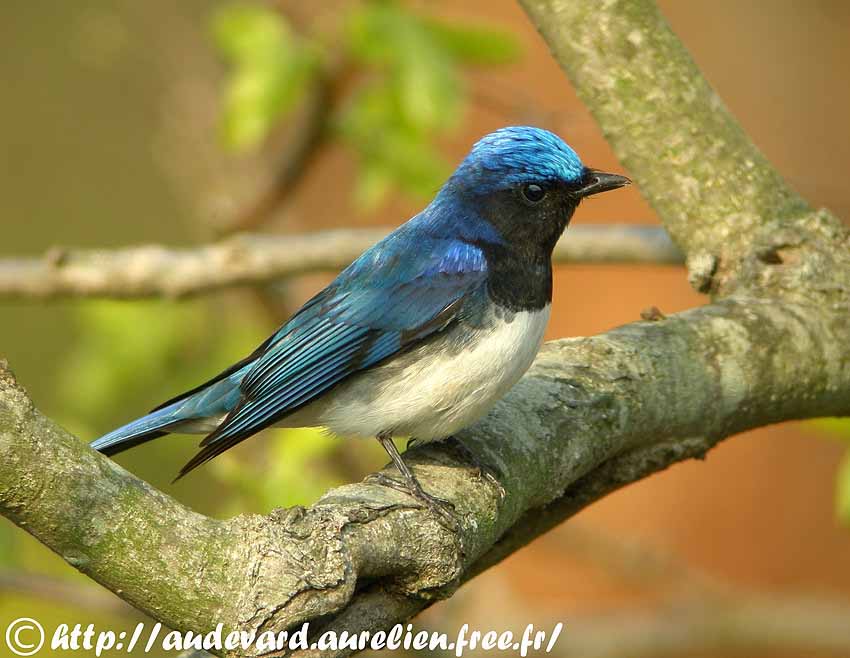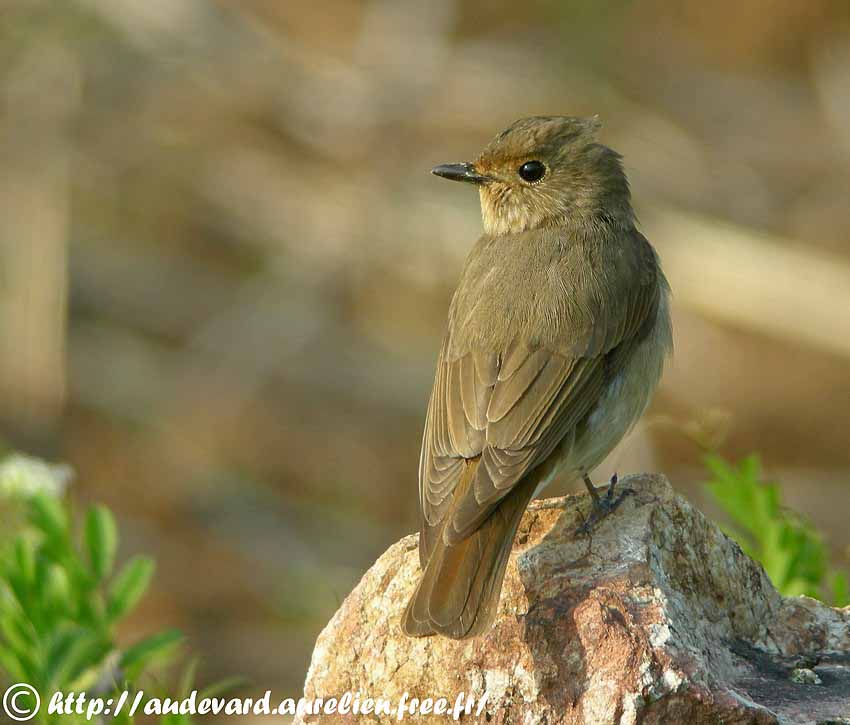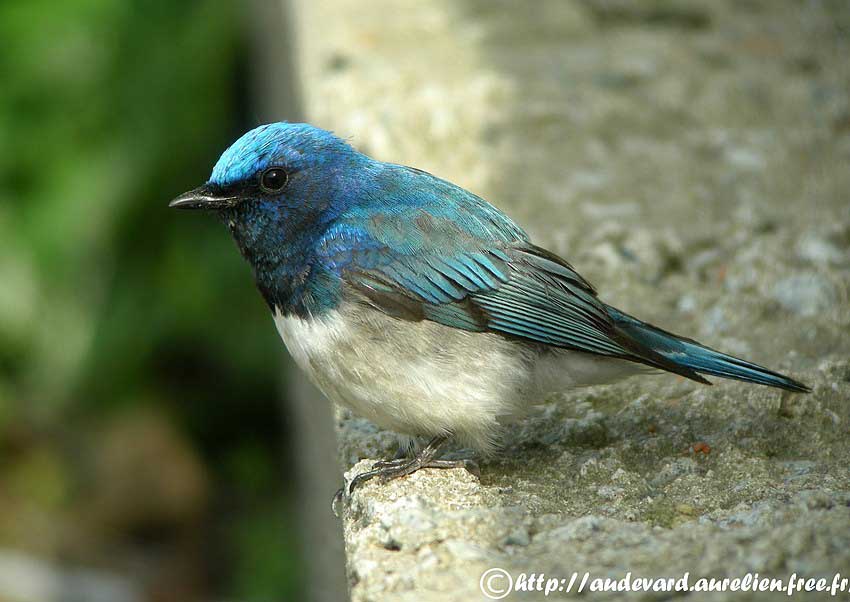
Blue and White Flycatcher
Cyanoptila cyanomelana
Passeriforme Order – Muscicapidae Family
BIOMETRICS:
Length: 16-17 cm; Weight: 25 g
DESCRIPTION:
Blue-and-white Flycatcher is very common in Korea where it is summer visitor.
Adult male has most of upperparts cobalt-blue, including upperwing-coverts, flight feather edges and tail. The primaries are black. Secondary feathers show black inner webs. The outer tail feathers are white at the base, only visible in flight.
On the underparts, chin, throat, breast and flanks are black, whereas belly and vent are white.
On the head, crown and nape are shiny cobalt-blue. The lower part of the forehead and face are black.
The bill is black. Eyes are dark brown. Legs and feet are dusky.

Female is different. She has grey-brown upperparts, including head and face. Wings are blackish, with broad rufous-brown edges on tertials. Uppertail coverts and tail are rufous-brown with darker outer rectrices.
On the underparts, chin and throat are grey to grey-brown, with distinct creamy throat patch. Breast and flanks are whitish, washed olive-grey. Belly and vent are whitish.
The bare parts are as in male, and she has an indistinct pale eye-ring.
Juvenile resembles female, but young male has bluish uppertail-coverts, tail and edges of flight feathers.
The first-year is almost similar to adult, with buff tips on secondary wing-coverts and inner flight feathers.

We can find two subspecies:
C.c. cyanomelana, has black head, throat and breast.
C.c. cumatilis, shows turquoise or azure-blue plumage instead of cobalt-blue in nominate. Face is mostly deep greenish-blue. Female is darker than nominate race.
VOICE: SOUNDS BY XENO-CANTO
Blue-and-white Flycatcher sings mainly at dawn and dusk. Its song is rich, fluted and melodious “hi-hwi-pipipi, tsi tsi tsi”.
Calls are harsh “tchk-tchk”, or softer, with “tic” or “tac” sounds.
This species is usually silent in winter.
HABITAT:
Blue-and-white Flycatcher lives in wooded areas in lowlands and submontane forests such as taiga, wooded slopes and gullies at up to 1200 metres of elevation. It can be also found in scrub, bushes and plantations.
During migration or on wintering areas, it can be found in coastal woodlands, parks and gardens. It may winter at high altitudes in Borneo, up to 2000 metres.
RANGE:
Blue-and white Flycatcher breeds in Japan, Korea, parts of China and Russia. It winters in South East Asia (Vietnam, Cambodia, Thailand, Sumatra and Borneo).
BEHAVIOUR:
Blue-and-white Flycatcher often adopts upright stance with frequent slow up and down tail movements and flicking wings. These movements are used in several situations, such as visual contact between mates, aggressive display behaviour, or disturbances of preys for easier caught.
It hunts from a perch, swooping down to the ground for feeding, and coming back to another perch. This small bird feeds on small invertebrates, larvae and some berries.

It is usually seen alone or in pairs, and it is very active. It gleans insects in the lower branches or in under storey, but it usually forages at mid and upper levels of canopy. It also performs sallies for flying insects. It is mainly arboreal.
Blue-and-white Flycatcher is territorial during breeding season. Some displays occur, showing the male offering food to female during courtship. This behaviour maintains the pair-bonds.
Blue-and-white Flycatcher is migratory, and moves south to wintering areas.
FLIGHT:
Blue-and-white Flycatcher catches insects in flight or by sallies.
REPRODUCTION:
Breeding season occurs between May and early August.
Blue-and-white Flycatcher often builds its nest near the ground, sheltered by vegetation or branches. The nest may be situated in crevice in cliff, among the roots of a tree, or under the overhanging bank of a stream.
The structure is cup-shaped, and made with moss, some plant fibres and parts of lichens.
Female lays 4 to 6 pale brown eggs with some markings. Incubation lasts about two weeks, by female. Both parents rear the chicks and take turns for catching preys.
The Blue-and-white Flycatcher’s nest is sometimes parasitized by Cuculus fugax.
DIET:
Blue-and-white Flycatcher feeds mainly on insects and larvae, such as beetles, moths and bees. It also consumes some berries, including unripe green berries.
PROTECTION / THREATS / STATUS:
Blue-and-white Flycatcher is common or locally common in most parts of the range. It is uncommon in China.
This species is not threatened at this moment.
Fr: Gobemouche bleu
All: Japanschnäpper
Esp: Papamoscas Blanco y Azul
Ital: Pigliamosche blu e bianco
Nd: Blauw-witte Vliegenvanger
Russe: Синяя мухоловка
Sd: Blåvit flugsnappare
Photographs by Aurélien Audevard
His website : OUESSANT DIGISCOPING
Text by Nicole Bouglouan
Sources:
HANDBOOK OF THE BIRDS OF THE WORLD Vol 11 by Josep del Hoyo, Andrew Elliott and David Christie - Lynx Edicions - ISBN: 849655306X
BIRDS OF THE MIDDLE EAST by R.F. Porter, S. Christensen, P Schiermacker-Ansen C.Helm - ISBN: 0713670169
L’ENCYCLOPEDIE MONDIALE DES OISEAUX - Dr Christopher M. Perrins - BORDAS - ISBN: 2040185607